Alpine salamander
The alpine salamander (Salamandra atra) is a black salamander that can be found in the French Alps, and through the mountainous range in Europe.[2] It is a member of the genus Salamandra. Their species name, atra, may be derived from the Latin ater, meaning dull black.[3] The salamanders' coloration has evolved over time, as some species are completely monochrome black and others have yellow spotting and marks.[4][5][6][7] Their life expectancy is at least 10 years. There are four subspecies of the alpine salamander, with varied distribution and physical coloration.[8] Unlike other salamanders, whose larvae are developed in water, the alpine salamander and its subspecies are a fully terrestrial species in life and gestation.[8] They give birth to live young.[9]
| Alpine salamander | |
|---|---|
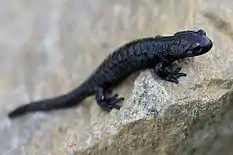 | |
| Scientific classification | |
| Domain: | Eukaryota |
| Kingdom: | Animalia |
| Phylum: | Chordata |
| Class: | Amphibia |
| Order: | Urodela |
| Family: | Salamandridae |
| Genus: | Salamandra |
| Species: | S. atra |
| Binomial name | |
| Salamandra atra Laurenti, 1768 | |
 | |
Alpine salamanders produce toxic compounds from their skin.[8] These compounds may protect them from both predator and microbial threats.[10][11][12][13]
Description
Alpine salamanders are often small in size, and dark brown or black.[8] Members of the subspecies are not wholly black or brown monochrome, but rather have mosaic or spotted patterns.[8] Members of the subspecies Salamandra atra aurorae have bright splotches on its dorsal side and head. The color is often bright yellow, but can range to shades of white or even gray.[8] Distribution of the pigment is dependent on the distribution of certain cells, so may be smooth and even or patchy.[8]
Female S. atra tend to be larger than the males, and can grow up to 151 millimeters, or around 5.9 inches.[8] Males will grow to around 144 millimeters, or 5.6 inches: both measurements include the tail.[8] Males have swollen, visible cloacae, and are more slender than females.[8][14] The salamanders have parotid glands posterior and lateral to their eyes, giving them an elongated head shape.[8] They tend to have between 11 and 13 costal grooves along the sides of their bodies, and a double row of dorsal glands runs down their backs on either side of their spines, down to the tips of their tails.[8]
Coloration
Most alpine salamanders that are either completely black (melanistic) or predominantly black have the dark pigment as a baseline, but the evolution behind this dark coloring has a winding history.[4] Scientists have studied the hypothesis of if the salamanders start completely black, or if they evolved like that over time.[5] DNA-evidence traced through maternal lineages suggest the latter: that salamanders evolved their black coloration over time.[5]
Biological pigmentation is determined by presentation of specific color-producing cells, called chromatophores, which absorb and/or reflect light in a particular way to then appear as a color.[7][15] In S. atra, there are different cells present or activated, which yield different colors: melanophores contribute to the dark coloration by producing the dark pigment melanin,[7] while xanthophores produce a yellow pigment,[4] and iridophores are simply light-reflecting.[4] The fully-black phenotype seen in S. a. atra results from the salamanders' melanophores in the dermis and epidermis, producing melanin alone.[5][7] Xanthophore-iridophore complexes are responsible for production of yellow spotting, which appears bright.[5] In species without yellow patches, it appears that they do not ever develop these cells.[5] In S. a. aurorae or other salamanders with different coloration on different parts of their body, two distinct skin types are present: one that only contains melanophores (black), and one that has melanophores, xanthophores, and iridophores in combination.[7]
The yellow coloring on some alpine salamanders is thought to be an aposematic strategy to fend off predation.[11] The pure black coloring is also hypothesized to be a form of thermoregulation,[11] though it may also be considered a warning to some predators.[11]
Taxonomy and subspecies
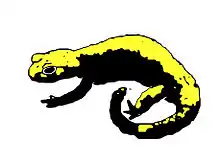

- S. a. atra is a fully melanistic (black) subspecies from central, eastern and Dinaric Alps.[6] This subspecies is the most widespread.[16]
- S. a. aurorae, the golden alpine salamander, has golden or yellow spots on its back and primarily lives in a small area in the Venetian Prealps near Asiago, and in the Italian Alps.[17]
- S. a. pasubiensis, with fewer yellow spots than S. a. aurorae, lives in a different part of the Venetian Prealps.
- S. a. prenjensis lives on Prenj Mountain, part of the Dinaric Alps in Bosnia and Herzegovina. The validity of this subspecies is yet to be confirmed, and some scientists in the field debate if this salamander should be considered its own independent species.[8][18]
Genetic analysis suggests that the Corsican fire salamander (Salamandra corsica) is the closest related species, and the black-yellow coloration is an ancestral feature of alpine salamanders. Proposed colonization from south (Prealps) to Alps was carried out by the fully melanistic (derived feature) S. a. atra after the last retreat of the ice sheets.[18]
Habitat and distribution
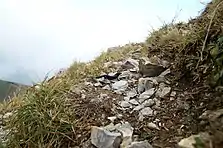
Habitat
As terrestrial organisms, these salamanders live on land.[8][19] S. atra tend to live underneath stones or logs, or in rocky crevices in their mountainous habitat.[8] They also are diurnal, and most active in the day with periods of inactivity, rest, or sleep at night.[16] They will engage in nocturnal activity on a weather-dependent basis.[20] Ideal weather for alpine salamanders is rainy or post-rain, at temperatures between 3 and 18 °C (37.4 and 64.4 °F).[16]
Geographic distribution
The alpine salamander is found from the France–Switzerland border at the western end of its range, all the way through Austria to the Dinaric Alps at the eastern edge of its territory. This salamander typically lives at altitudes above 700 metres (2,300 ft) above sea level, even reaching 2,000 metres (6,600 ft) of elevation.[8] The western Alps (in France and Italy) are inhabited by a similar species, Lanza's alpine salamander (Salamandra lanzai), in only one small area. S. atra generally live in forested biomes, particularly deciduous-coniferous mixes.[8] They also can inhabit meadows or grasslands in the mountains,[8] and tend to do well with a mix of tree types.[21][16]
Their range spans several nations, including: Slovenia, Croatia, Bosnia, Hersegovina, Montenegro, Kosovo, France, Italy, Austria.
Home range and territoriality
.jpg.webp)

They thrive in forest environments that have silver fir and beech trees.[21][22] Coniferous forests that have high proportions of Norway spruce and European larch trees also provide adequate habitats, even though the salamanders live on the ground floor.[21] Because alpine salamanders are completely terrestrial, they have on-land territories that they tend to return to throughout the day and for refuge. They often return to the same sites for much of their lives.[21] Any time that they leave their sites, they expose themselves to predation and also to the chance of losing their site.[21] Alpine salamanders are ectothermic, so losing a refuge or shelter could leave them exposed to the elements and be extremely costly, if not fatal,[21] due their lack of an internal thermoregulation mechanism.
This high dependency on a quality nest site supports the theory that many terrestrial salamanders, including S. atra, engage in territorial behaviors.[21] Capture-recapture methods suggest that the species is very stationary;[23] 12 metres (39 ft) was the maximum observed distance traveled by one individual during the summer season. About 120 individuals per hectare were counted in most suitable areas with over 2000 individuals per hectare also observed, suggesting that this rather cryptic species is quite abundant.[17]
Territorial behavior
They employ scent-marking techniques for territorial behaviors, and to mark their territories using fecal pellets so they can identify their own shelters.[21] Scent-marking is an intra-species communication, where chemical signals convey specific messages to other S. atra individuals.[21][24] Alpine salamanders can determine if a found fecal pellet has been left by a member of their same sex and/or species.[21] Thus, this technique serves a double purpose to warn other salamanders that that particular location has already been claimed.[21]
Females are more likely to return to their home site, while males are more emboldened to enter another male's territory.[21] Their fecal pellets allow them to both participate in homing behavior, or returning to their own site, and territoriality, and determine intruders on their territory or invade the spaces of others.[21]
Conservation
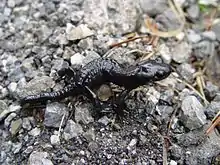
Alpine salamanders are not resilient to habitat changes— few terrestrial salamanders are— so risks of climate change altering their living spaces is severe.[23] Although alpine salamanders are listed as Least Concern on IUCN Red List, their numbers are decreasing.[1] Additionally, some subspecies of S. atra are in greater danger.[25] Population numbers are declining in S. a. aurorae, for example.
One of the greatest dangers to alpine salamanders overall is commercial deforestation in their habitats.[25] Machinery like tractors or other forestry tools can compress the soil, eliminating some of the small insects that S. atra eat or eliminating potential nooks and burrows for them to use as shelters.[25] Many scientists propose changes in the lumber industry as an attempt to heal these habitats.[25] These salamanders may also change their morphology as global temperatures rise.[26] Amphibians and other organisms that do not internally regulate their body temperature may need adaption mechanisms to remain at ideal physiological temperatures in the face of changing climates.[26] Other issues like acid rain or precipitation changes could prompt many animals, including alpine salamanders, to be forced into new habitats.[26] Alpine salamanders play a crucial role in their ecosystems.[27] There are already animal and ecosystem conservation laws in Europe, but many scholars recommend additional ones to protect the flora and fauna.[12]
Predators
Due to their toxicity,[10][11] as well as decreased concentration of animals at high altitudes,[28] researchers are unsure of consistent predators for alpine salamanders with limited observation.[8] These salamanders do move slowly, which could increase their risk of being caught.[28] Generally, predators of the broad category of toxic Salamandra species can include birds, rats and snakes, as well as other, larger carnivorous mammals like raccoons, minks, wild boars and foxes.[10]
One notable predator of S. atra is young snakes.[28] In particular, juvenile European adders (Vipera berus) pose a risk because they live at similarly high altitudes to alpine salamanders.[28] S. atra have been suggested to make up just under half of these snakes' diets in some locations.[28] They may hunt for alpine salamanders during early morning hours, when S. atra is most active.[28] There also has been recorded evidence of these snakes swallowing alpine salamanders.[28] V. berus, alongside the grass snake (Natrix natrix), are noted predators of alpine salamanders in the Italian Alps.[8]
Feeding
Male and female alpine salamanders have relatively similar diets.[29] Some specific organisms they prey on include species such as beetles, snails, millipedes, and spiders,[30] but alpine salamanders display preferences among prey.[29] S. atra typically consume organisms from the Coleoptera and mollusca taxa.[29] These taxa are the most crucial component of their diet. They also tend to eat larger prey since they themselves are larger salamanders.[29] Such preference indicates a dimensional selectivity, in which the energy intake of prey consumption is maximized.[29] Though alpine salamanders have definite dietary preferences, they have a substantial amount of variation in their diet[29] that corresponds to their own optimized physical needs and prey-catching abilities.
Mating and interactions
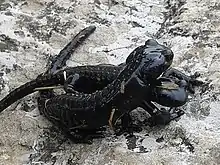
Mating pattern
The alpine salamander engages in a promiscuous mating pattern,[20] meaning that they engage in multiple partner pairings. Males travel farther than females do, potentially to follow a scent emitted by females, and typically while still in their juvenile stage.[20] Female S. atra find and defend their shelters, which is a potential reason that they may stay more local than males.[20]
Male-male behavior
Males are more likely to engage in chasing other males, as well as actually fighting with each other.[31] Oftentimes, one male will mount the other, loosely grasp it with his forearms, and start rubbing his head on the other male.[31] The two males will switch roles, and in one studied interaction, continued like this for seven minutes before parting ways.[31] In a second documented fight, the behavior was more intense. When one member tried to leave, the other male chased it to re-engage.[31] This encounter lasted eight minutes. There is both photographic and video evidence of these behaviors.[31] Researchers are unsure if it is caused by territoriality, confusion on sexual identification and mistaken mating, or true combat.[31]
Gestation and reproduction
Alpine salamanders live in a sex ratio of 1:1.[32] Mating occurs on land. The male clasps the female at the forelegs, and fertilization is internal. S. atra are categorized as viviparous, meaning that their young are born alive and unlike many other amphibians, do not go through metamorphosis[8][9] They give birth to 2 young, sometimes 3 or 4. New young alpine salamanders may measure as long as 50 millimetres (2 in) at birth, with the mother measuring only 120 millimetres (4.7 in).
Female alpine salamanders have uteruses that are composed of a single luminal epithelial cell layer, connective tissue, and smooth muscle.[9] The uterine eggs are large and numerous, but, as a rule, only one fully develops in each uterus. The embryo is nourished on the yolk of the other eggs, which more or less dissolve to form a large mass of nutrient matter. The egg mass can be as long as between 25 mm and 40 mm long.[9] The embryo passes through three stages:[33]
- The first stage is when they are still enclosed within the egg and living on its own yolk.[33]
- The second stage is when they are free, within the vitelline mass, eating it directly with their mouths.[9][33]
- The final stage occurs when there is no more vitelline mass. The embryo is possessed of long external gills, which serve as an exchange of nutritive fluid through the maternal uterus, these gills functioning in the same way as the chorionic villi of the mammalian egg.[9][33]
Generally, at altitudes of 650–1,000 metres (2,130–3,280 ft) above sea level, a pregnancy lasts two years, and at altitudes of 1,400-1,700 m above sea level, the pregnancy lasts around three years, though anything within a 2-4 year range is considered standard.[9] Alpine salamander embryos are unique in how they are able to take in these nutrients through a long gestation.[9] A portion of the mother's uterine wall becomes nourishment after the salamanders have already eaten the unfertilized eggs,[9] (called oophagy or stage 1 and 2).[9] They then partake in epitheliophagy, or stage 3, where they ingest these zona trophica cells until birth, and have special tooth-like developments that allow it to do so without detriment to the mother.[9]
Physiology
Glands and toxins
As mentioned above, alpine salamanders have poison glands.[8] They are known to produce some alkaloid molecules and peptide products, and thus have a mustard-like scent associated with them.[10] Salamandra bioproduction is still a developing research area. Salamandarines are a chemical secretion produced by the skin of alpine salamanders, as well as some fire salamanders.[8][34] They are neurotoxins, and are synthesized via a biochemical pathway, completely independent of dietary intake.[8] This means that they make these chemicals within their bodies, not as a result of ingesting poisonous substances.The starting material for this nerve-block is most likely cholesterol, and it is about twice as potent as cyanide.[8] This pales in comparison to other toxins produced by salamanders, but S. atra do not only use this powerful substance to paralyze prey: they may have antimicrobial properties that protect them against bacterial and fungal infections.[8][35] Salamandorone is another biochemical compound produced by S. atra, and though it is less potent against prey it is the strongest antimicrobial weapon these salamanders have.[8][13][35]
There are two main categories of toxin studied, samandarine and samandarone.[8][11] There also exist many other compounds, as well as miscellaneous alkaloid secretions.[8] Both samandarine and samandarone are produced by S. atra species.[11] It is hypothesized that salamandarine is more commonly produced in alpine salamanders as a predator defense mechanism, and salamandorones are produced where there is greater infection risk.[8] There is also noted geographic variation in toxin production by alpine salamanders.[8]
Immunobiology and protection
Samandarone, a toxin they produce via skin secretion, has noted antimicrobial activity.[8] In one study, this toxin was present where there was infection risk, but at low concentration.[8] There is a wide arsenal of toxins produced by S. atra , many of which are antimicrobial or could be precursors to other protective molecules.[8] Nonetheless, the alpine salamander has been relatively lucky in avoiding infection with amphian chytrid fungus[35] compared to other amphibian species.[35][36] This dangerous fungal infection, caused by Batrachochytrium dendrobatidis (Bd) has decimated amphibian populations on every continent.[35] Bd is present in the Alps where alpine salamanders live, but in a study performed in 2012, there were no salamanders who tested positive when swabbed.[35] This may be because Bd infections are more common in species who spend more of their time in water, and since the alpine salamanders are terrestrial, they are less susceptible.[35] An alternate hypothesis proposes that S. atra are resistant via their skin microbiome or a produced molecule, thus granting them immunity.[35][37] This theory is untested, but considering how many salamanders excrete biological toxins, plausible.[35][37]
References
- IUCN SSC Amphibian Specialist Group (2022). "Salamandra atra". IUCN Red List of Threatened Species. 2022: e.T19843A89706038. doi:10.2305/IUCN.UK.2022-1.RLTS.T19843A89706038.en. Retrieved 21 October 2023.
- "Salamandre noire unique - La Salamandre". Archived from the original on 2020-07-02.
- "Atra meaning in English » DictZone Latin-English dictionary". dictzone.com. Retrieved 2022-12-05.
- Burgon, James D.; Vieites, David R.; Jacobs, Arne; Weidt, Stefan K.; Gunter, Helen M.; Steinfartz, Sebastian; Burgess, Karl; Mable, Barbara K.; Elmer, Kathryn R. (April 2020). "Functional colour genes and signals of selection in colour‐polymorphic salamanders". Molecular Ecology. 29 (7): 1284–1299. doi:10.1111/mec.15411. ISSN 0962-1083. PMID 32159878. S2CID 212664862.
- Bonato, Lucio; Steinfartz, Sebastian (2005-01-01). "Evolution of the melanistic colour in the Alpine salamander Salamandra atra as revealed by a new subspecies from the Venetian Prealps". Italian Journal of Zoology. 72 (3): 253–260. doi:10.1080/11250000509356680. ISSN 1125-0003. S2CID 83504324.
- "Salamandre noir". Karch.Ch (Swiss information center for amphibians and reptiles). Retrieved 29 June 2020.
- TREVISAN, PIERLUIGI; PEDERZOLI, AURORA; BAROZZI, GIANCARLO (October 1991). "Pigmentary System of the Adult Alpine Salamander Salamandra atra atra (Laur., 1768)". Pigment Cell Research. 4 (4): 151–157. doi:10.1111/j.1600-0749.1991.tb00432.x. ISSN 0893-5785. PMID 1816547.
- DE MEESTER, Gilles; ŠUNJE, Emina; PRINSEN, Els; VERBRUGGEN, Erik; VAN DAMME, Raoul (2020-10-13). "Toxin variation among salamander populations: discussing potential causes and future directions". Integrative Zoology. 16 (3): 336–353. doi:10.1111/1749-4877.12492. hdl:10067/1718680151162165141. ISSN 1749-4877. PMID 32965720. S2CID 221862886.
- Guex, G. -D.; Chen, P. S. (December 1986). "Epitheliophagy: Intrauterine cell nourishment in the viviparous alpine salamander,Salamandra atra (Laur.)". Experientia. 42 (11–12): 1205–1218. doi:10.1007/bf01946392. ISSN 0014-4754. PMID 3780941. S2CID 35011685.
- Lüddecke, Tim; Schulz, Stefan; Steinfartz, Sebastian; Vences, Miguel (2018-09-04). "A salamander's toxic arsenal: review of skin poison diversity and function in true salamanders, genus Salamandra". The Science of Nature. 105 (9): 56. Bibcode:2018SciNa.105...56L. doi:10.1007/s00114-018-1579-4. ISSN 1432-1904. PMID 30291447. S2CID 253637272.
- Vences, Miguel; Sanchez, Eugenia; Hauswaldt, J. Susanne; Eikelmann, Daniel; Rodríguez, Ariel; Carranza, Salvador; Donaire, David; Gehara, Marcelo; Helfer, Véronique; Lötters, Stefan; Werner, Philine; Schulz, Stefan; Steinfartz, Sebastian (2014-04-01). "Nuclear and mitochondrial multilocus phylogeny and survey of alkaloid content in true salamanders of the genus Salamandra (Salamandridae)". Molecular Phylogenetics and Evolution. 73: 208–216. doi:10.1016/j.ympev.2013.12.009. ISSN 1055-7903. PMID 24412216.
- Scalera, Riccardo (2004-07-01). "The legal framework for the protection of amphibians and reptiles in Italy: an annotated overview of the provisions at the international, European community, national and regional level". Italian Journal of Zoology. 71 (sup002): 21–32. doi:10.1080/11250003.2004.9525560. ISSN 1125-0003.
- Spitzen - van der Sluijs, Annemarieke; Stegen, Gwij; Bogaerts, Sergé; Canessa, Stefano; Steinfartz, Sebastian; Janssen, Nico; Bosman, Wilbert; Pasmans, Frank; Martel, An (2018-02-28). "Post-epizootic salamander persistence in a disease-free refugium suggests poor dispersal ability of Batrachochytrium salamandrivorans". Scientific Reports. 8 (1): 3800. Bibcode:2018NatSR...8.3800S. doi:10.1038/s41598-018-22225-9. ISSN 2045-2322. PMC 5830533. PMID 29491409. S2CID 3562074.
- "Salamandra atra". AmphibiaWeb. 6 December 2018.
- PEDERZOLI, AURORA; TREVISAN, PIERLUIGI (March 1989). "Pigmentary System of the Adult Alpine Salamander Salamandra atra aurorae (Trevisan, 1982)". Pigment Cell Research. 3 (2): 80–89. doi:10.1111/j.1600-0749.1989.tb00266.x. ISSN 0893-5785. PMID 2385569.
- Romano, Antonio; Anderle, Matteo; Forti, Alessandro; Partel, Piergiovanni; Pedrini, Paolo (2018-12-31). "Population density, sex ratio and body size in a population of Salamandra atra atra on the Dolomites". Acta Herpetologica. 13 (2): 195–199 Pages. doi:10.13128/ACTA_HERPETOL-22592.
- Bonato, Fracasso. Movements, distribution pattern and density in a population of Salamandra atra aurorae (Caudata: Salamandridae). Amphibia-Reptilia 2003, 24, 251-260.
- Bonato & Steinfartz. Evolution of the melanistic color in the Alpine salamander Salamandra atra as revealed by a new subspecies from the Venetian prealps. Italian Journal of Zoology 2001, 72, 253-260.
- Werner, Philine; Lötters, Stefan; Schmidt, Benedikt R.; Engler, Jan O.; Rödder, Dennis (2013-03-27). "The role of climate for the range limits of parapatric European land salamanders". Ecography. 36 (10): 1127–1137. doi:10.1111/j.1600-0587.2013.00242.x. ISSN 0906-7590.
- Helfer, V.; Broquet, T.; Fumagalli, L. (October 2012). "Sex-specific estimates of dispersal show female philopatry and male dispersal in a promiscuous amphibian, the alpine salamander ( Salamandra atra )". Molecular Ecology. 21 (19): 4706–4720. doi:10.1111/j.1365-294X.2012.05742.x. PMID 22934886. S2CID 22175429.
- Gautier, Patrick G.; Miaud, Claude (2003-01-01). "Faecal pellets used as an economic territorial marker in two terrestrial alpine salamanders". Écoscience. 10 (2): 134–139. doi:10.1080/11956860.2003.11682759. ISSN 1195-6860. S2CID 89090083.
- Bonato, Lucio; Fracasso, Giancarlo (2003). "Movements, distribution pattern and density in a population of Salamandra atra aurorae (Caudata: Salamandridae)". Amphibia-Reptilia. 24 (3): 251–260. doi:10.1163/156853803322440736. ISSN 0173-5373.
- Basile, Marco; Romano, Antonio; Costa, Andrea; Posillico, Mario; Scinti Roger, Daniele; Crisci, Aldo; Raimondi, Ranieri; Altea, Tiziana; Garfì, Vittorio; Santopuoli, Giovanni; Marchetti, Marco; Salvidio, Sebastiano; De Cinti, Bruno; Matteucci, Giorgio (2017-09-12). "Seasonality and microhabitat selection in a forest-dwelling salamander". The Science of Nature. 104 (9–10): 80. Bibcode:2017SciNa.104...80B. doi:10.1007/s00114-017-1500-6. ISSN 0028-1042. PMID 28900670. S2CID 253640324.
- Simons, Richard R.; Felgenhauer, Bruce E.; Jaeger, Robert G. (1994-07-01). "Salamander scent marks: site of production and their role in territorial defence". Animal Behaviour. 48 (1): 97–103. doi:10.1006/anbe.1994.1215. ISSN 0003-3472. S2CID 53150185.
- Romano, Antonio; Costa, Andrea; Salvidio, Sebastiano; Menegon, Michele; Garollo, Elena; Tabarelli de Fatis, Karol; Miserocchi, Danio; Matteucci, Giorgio; Pedrini, Paolo (September 2018). "Forest management and conservation of an elusive amphibian in the Alps: Habitat selection by the Golden Alpine Salamander reveals the importance of fine woody debris". Forest Ecology and Management. 424: 338–344. doi:10.1016/j.foreco.2018.04.052. ISSN 0378-1127. S2CID 89706693.
- Ficetola, Gentile Francesco; Colleoni, Emiliano; Renaud, Julien; Scali, Stefano; Padoa-Schioppa, Emilio; Thuiller, Wilfried (June 2016). "Morphological variation in salamanders and their potential response to climate change". Global Change Biology. 22 (6): 2013–2024. Bibcode:2016GCBio..22.2013F. doi:10.1111/gcb.13255. PMC 4972144. PMID 26910389.
- Reinthaler-Lottermoser, Ursula; et al. (8 October 2018). "A new approach for surveying the Alpine Salamander (Salamandra atra) in Austria". Acta Herpetologic: 249–253.
- Luiselli, Luca; Anibaldi, Claudio; Capula, Massimo (August 12, 1994). "The diet of juvenile adders, Vipera berus, in an alpine habitat". Amphibia-Reptilia: 404–407 – via Brill.
- Roner, Luca; Costa, Andrea; Pedrini, Paolo; Matteucci, Giorgio; Leonardi, Stefano; Romano, Antonio (May 2020). "A Midsummer Night's Diet: Snapshot on Trophic Strategy of the Alpine Salamander, Salamandra atra". Diversity. 12 (5): 202. doi:10.3390/d12050202. ISSN 1424-2818.
- Šunje, Emina; Courant, Julien; Vesnić, Adi; Koren, Toni; Lukić Bilela, Lada; Van Damme, Raoul (2022-09-20). "Patterns of variation in dietary composition among four populations of Alpine salamanders (Salamandra atra prenjensis)". Amphibia-Reptilia. 43 (4): 331–345. doi:10.1163/15685381-bja10100. hdl:10067/1943920151162165141. ISSN 0173-5373. S2CID 252444327.
- Di Nicola, Matteo Ricardo (November 2022). "Male-male interactions in Alpine salamanders, Salamandra atra atra Laurenti, 1768, with an overview of the main cases reported for the whole genus Salamandra Garsault, 1764". Herpetology Notes. 15: 601–604.
- Body size, population structure and fecundity traits of Salamandra atra atra (Amphibia, Urodela, Salamandridae) population from the northeastern Italian Alps. Vol. 68. Luiselli, Andreone, Capizzi, Anibaldi: Italian Journal of Zoology. 2001. pp. 125–130.
- Chisholm, Hugh, ed. (1911). . Encyclopædia Britannica. Vol. 1 (11th ed.). Cambridge University Press.
- De Meester, Gilles; Šunje, Emina; Prinsen, Els; Verbruggen, Erik; Van Damme, Raoul (May 2021). "Toxin variation among salamander populations: discussing potential causes and future directions". Integrative Zoology. 16 (3): 336–353. doi:10.1111/1749-4877.12492. hdl:10067/1718680151162165141. ISSN 1749-4877. PMID 32965720. S2CID 221862886.
- R Lötters; S Kielgast; J Sztatecsny; M Wagner; N Schulte; U Werner; P Rödder; D Dambach; J Reissner; T Hochkirch; A Schmidt, B (2012-04-30). Absence of infection with the amphibian chytrid fungus in the terrestrial Alpine salamander, Salamandra atra. Deutsche Gesellschaft für Herpetologie und Terrarienkunde (DGHT). OCLC 1030045649.
- Feldmeier, Stephan; Schefczyk, Lukas; Wagner, Norman; Heinemann, Günther; Veith, Michael; Lötters, Stefan (2016-10-31). "Exploring the Distribution of the Spreading Lethal Salamander Chytrid Fungus in Its Invasive Range in Europe – A Macroecological Approach". PLOS ONE. 11 (10): e0165682. Bibcode:2016PLoSO..1165682F. doi:10.1371/journal.pone.0165682. ISSN 1932-6203. PMC 5087956. PMID 27798698.
- Woodhams, D. C.; Rollins-Smith, L. A.; Alford, R. A.; Simon, M. A.; Harris, R. N. (November 2007). "Innate immune defenses of amphibian skin: antimicrobial peptides and more". Animal Conservation. 10 (4): 425–428. doi:10.1111/j.1469-1795.2007.00150.x. ISSN 1367-9430. S2CID 84293044.
External links
 Media related to Salamandra atra at Wikimedia Commons
Media related to Salamandra atra at Wikimedia Commons Data related to Salamandra atra at Wikispecies
Data related to Salamandra atra at Wikispecies- European Field Herping Community. "Picture gallery of S. a. atra, S. a. aurorae and S. a.pasubiensis subspecies". Archived from the original on 2015-09-24. Retrieved 2011-02-20.
- Emina Šunje. "Salamandra atra prenjensis". Archived from the original on 2021-04-27. Retrieved 2011-02-20. (in Bosnian)
